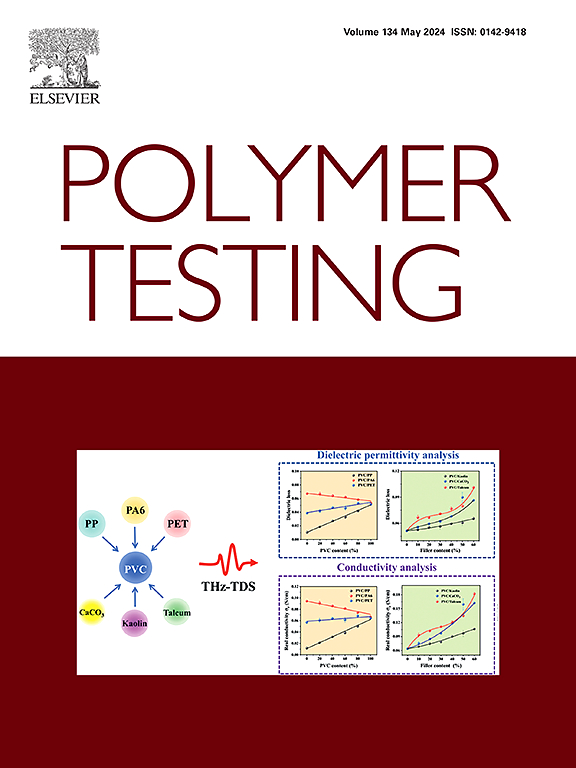Synthesis of phosphorus-containing modifier based on phenolic epoxy resin and its application in flexible poly(vinyl chloride)/magnesium hydroxide composites
IF 5
2区 材料科学
Q1 MATERIALS SCIENCE, CHARACTERIZATION & TESTING
引用次数: 0
Abstract
In this study, a phosphorus-containing and polyether structure modifier, phenolic epoxy phosphate ester (PEPE), was prepared by the reaction of phenolic epoxy resin (EPN) and phosphoric acid. It was used to solve the trade-off dilemma of simultaneously improving the mechanical properties and flame resistance of flexible poly (vinyl chloride) (fPVC)/magnesium hydroxide (MH) composites. The peak heat release rate, total heat release, peak smoke production rate, and total smoke production of the fPVC/MHPEPE-5 (PEPE modified MH as filler) composite were decreased by 35.31 %, 49.2 %, 40.42 %, and 27.26 %, respectively, in comparison with the fPVC/MH composite. More importantly, the fPVC/MHPEPE-5 composite passed V-0 rating in the UL-94 test, while the fPVC and fPVC/MH composite passed V-2 and V-1 rating. The presence of phosphorus compounds in the condensed phase promoted the formation of a dense char residue of the fPVC/MHPEPE-5 composite. Therefore, the heat and flammable volatiles cannot migrate between the substrate zone and the combustion zone. In the gas phase, the dilution effect of H2O reduced the concentration of oxygen and combustible volatiles. The radicals quenching effect of the primary and secondary pyrolysis products of PEPE (such as PO· and PO2·) with ·H and ·OH. radicals played a crucial role in flame extinguishing and combustion termination. In addition, the scanning electron microscopy results showed that MHPEPE performed good compatibility with the fPVC matrix. The tensile and impact strength of the fPVC/MHPEPE-5 composite was 12.19 % and 19.26 % higher than that of the fPVC/MH composite, respectively.
基于酚醛环氧树脂的含磷改性剂的合成及其在柔性聚氯乙烯/氢氧化镁复合材料中的应用
本研究通过酚醛环氧树脂(EPN)和磷酸的反应制备了一种含磷聚醚结构改性剂--酚醛环氧磷酸酯(PEPE)。它被用来解决同时改善柔性聚氯乙烯(fPVC)/氢氧化镁(MH)复合材料机械性能和阻燃性能的两难问题。与 fPVC/MH 复合材料相比,fPVC/MHPEPE-5(PEPE 改性氢氧化镁作为填料)复合材料的峰值放热率、总放热率、峰值产烟率和总产烟量分别降低了 35.31 %、49.2 %、40.42 % 和 27.26 %。更重要的是,在 UL-94 测试中,fPVC/MHPEPE-5 复合材料通过了 V-0 评级,而 fPVC 和 fPVC/MH 复合材料则通过了 V-2 和 V-1 评级。冷凝相中磷化合物的存在促进了 fPVC/MHPEPE-5 复合材料形成致密的炭渣。因此,热量和易燃挥发物无法在基材区和燃烧区之间迁移。在气相中,H2O 的稀释作用降低了氧气和可燃挥发物的浓度。珠光聚醚的一次和二次热解产物(如 PO- 和 PO2-)与 -H 和 -OH 自由基的自由基淬灭效应在熄灭火焰和终止燃烧方面发挥了关键作用。此外,扫描电子显微镜结果表明,MHPEPE 与 fPVC 基体具有良好的相容性。fPVC/MHPEPE-5 复合材料的拉伸强度和冲击强度分别比 fPVC/MH 复合材料高 12.19 % 和 19.26 %。
本文章由计算机程序翻译,如有差异,请以英文原文为准。
求助全文
约1分钟内获得全文
求助全文
来源期刊

Polymer Testing
工程技术-材料科学:表征与测试
CiteScore
10.70
自引率
5.90%
发文量
328
审稿时长
44 days
期刊介绍:
Polymer Testing focuses on the testing, analysis and characterization of polymer materials, including both synthetic and natural or biobased polymers. Novel testing methods and the testing of novel polymeric materials in bulk, solution and dispersion is covered. In addition, we welcome the submission of the testing of polymeric materials for a wide range of applications and industrial products as well as nanoscale characterization.
The scope includes but is not limited to the following main topics:
Novel testing methods and Chemical analysis
• mechanical, thermal, electrical, chemical, imaging, spectroscopy, scattering and rheology
Physical properties and behaviour of novel polymer systems
• nanoscale properties, morphology, transport properties
Degradation and recycling of polymeric materials when combined with novel testing or characterization methods
• degradation, biodegradation, ageing and fire retardancy
Modelling and Simulation work will be only considered when it is linked to new or previously published experimental results.
 求助内容:
求助内容: 应助结果提醒方式:
应助结果提醒方式:


